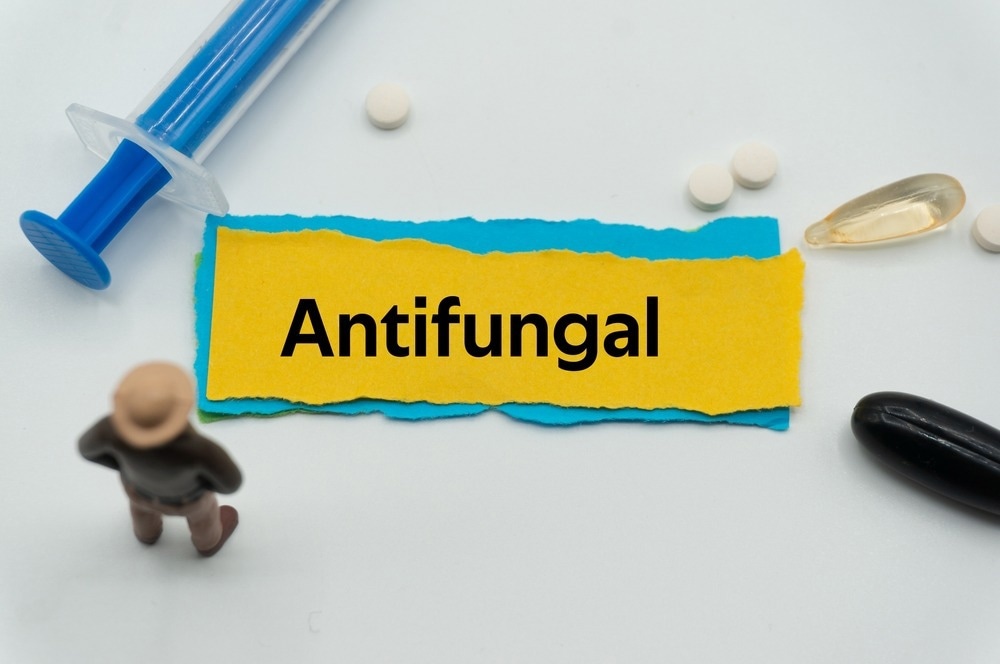Cryptococcus neoformans is an infectious fungus that causes cryptococcal meningitis. This yeast-like fungus is resistant to antifungal treatment with fluconazole and has an 80% mortality rate across the globe.

Study: Application of Fluconazole-Loaded pH-Sensitive Lipid Nanoparticles for Enhanced Antifungal Therapy. Image Credit: evan_huang/Shutterstock.com
An article published in ACS Applied Materials and Interfaces discussed a novel approach to increase fluconazole’s availability and targetability at the infection site. pH-sensitive lipid nanoparticles were developed based on the acidic environment surrounding the Cryptococcus neoformans infected area.
The fluconazole-based lipid nanoparticles constituted a novel synthetic ionizable lipid 2-morpholinoethyl oleate (O2ME) and neutral lipid monoolein (MO). At neutral pH, due to the presence of O2ME, the lipid nanoparticles had a neutral charge and exhibited a crystalline hexagonal nanostructure (hexosomes). On the other hand, at an acidic pH, the lipid nanoparticles had a positive charge with cubic nanostructure (cubosomes).
The positive charge of the nanoparticles was useful for their interaction with the fungal cell wall with a negative charge. These interactions helped evaluate minimum inhibition concentration (MIC50 and MIC90) values for fluconazole-based lipid nanoparticles. Moreover, these values were less compared to that of the free-fluconazole control.
Scanning electron microscopy (SEM) and confocal laser scanning microscopy (CLSM) supported the experimentally obtained MIC values, showing heavily distorted fungal cells exposed to fluconazole-based lipid nanoparticles at acidic pH, demonstrating the cytoplasmic molecules’ efflux.
Antimicrobial Resistance Against Fungal Infections
Antimicrobial-resistant fungal infections are concerning due to the limited availability of antifungal drugs and their related toxicity. Moreover, drug toxicity due to its nonspecific targeting may cause various side effects and reduces the patient’s compliance to the antifungal treatment.
Infectious disease-causing Cryptococcus neoformans is resistant to the antifungal drug fluconazole due to its target gene mutation that reduces the affinity towards the antifungal drug and efflux pumps and enhances the expulsion of the antifungal agent from the fungal cell. Hence, due to the lack of preventive tools or efficient treatment for drug-resistant fungal infections, the mortalities and morbidities are persistently increasing.
Thus, improved therapeutic strategies to treat the emerging functional infections alongside the prevention of increasing drug resistance is a prominent area of research. One way to tackle antimicrobial resistance is to enhance the antimicrobial effect of fluconazole by improving its efficacy, realized by incorporating fluconazole into nanocarriers.
Although pH-sensitive nanocarriers are extensively used in cancer treatment, their use in antifungal treatment is less explored. Moreover, cubosomes and hexosomes are lyotropic liquid crystalline (LLC) lipid nanoparticles that can serve as potential drug delivery vehicles due to their amphiphilic nature in carrying hydrophobic and hydrophilic drugs with high loading capacity.
Fluconazole-loaded Lipid Nanoparticles for Enhanced Antifungal Therapy
The present study aimed to develop pH-sensitive LLC lipid nanoparticles as drug delivery agents for fluconazole. Thus, pH-sensitive fluconazole-loaded hexosomes and cubosomes were prepared to treat fungal infections caused by fluconazole-resistant Cryptococcus neoformans isolates.
The formulation of lipid nanoparticles consisted of commercially available MO lipids and novel O2ME aminolipids. These lipid nanoparticles included neutral charged hexosomes at neutral pH and positively charged (cationic) cubosomes at pH 5. Consequently, the antifungal activity of these lipid nanoparticles was investigated at pH 5 and 7 by using microscopy and spectroscopy techniques, SEM and CLSM.
Incorporating O2ME into MO nanoparticles and encapsulating fluconazole into them resulted in desired fluconazole-loaded O2ME-lipid nanoparticles with antifungal activity. The O2ME-based lipid nanoparticles and their fluconazole-loaded counterparts had a particle size of 244 ± 2 and 256 ± 4 nanometers, respectively, which were in the range of MO-based lipid nanoparticles studied previously.
The results obtained for the antifungal activity revealed that fluconazole-loaded O2ME-based lipid nanoparticles showed an enhanced antifungal activity than free fluconazole. Moreover, at low pH, the cationic nature of fluconazole-loaded O2ME-based lipid nanoparticles mediated electrostatic binding. Its cubic structure facilitated the fusion of the lipid nanoparticles with the fungal cell membrane to exhibit an antifungal effect.
Conclusion
To summarize, pH-sensitive fluconazole-loaded lipid nanoparticles were formulated to combat the fluconazole-resistant fungal species, such as Cryptococcus neoformans. The lipid nanoparticles used for fluconazole encapsulation consist of neutral lipid MO and an ionizable lipid O2ME. The obtained fluconazole-loaded O2ME-based lipid nanoparticles existed as neutrally charged hexosomes at pH 7 and positively charged cubosomes at pH 5.
The as-prepared, fluconazole-loaded O2ME-based lipid nanoparticles showed up to 90% antifungal activity in acidic pH (pH 5), while free fluconazole failed to exhibit antifungal activity at both neutral and acidic pH. Additionally, the MIC50 value of fluconazole-loaded O2ME-based lipid nanoparticles was lower than free fluconazole. This improved antifungal activity was due to the positive charge of synthesized lipid nanoparticles at low pH and their corresponding cubic nanostructures.
Thus, the present work highlighted the emergence of optimizing the antimicrobial drug delivery agents that target resistant microbial infections, wherein pH-sensitive lipid nanoparticles could serve as potential candidates for future studies.
Reference
Rajesh, S., Gangadoo, S., Nguyen, H., Zhai, J., Dekiwadia, C., Drummond, CJ., Chapman, J et al. (2022). Application of Fluconazole-Loaded pH-Sensitive Lipid Nanoparticles for Enhanced Antifungal Therapy. ACS Applied Materials & Interfaces. https://doi.org/10.1021/acsami.2c05165
Disclaimer: The views expressed here are those of the author expressed in their private capacity and do not necessarily represent the views of AZoM.com Limited T/A AZoNetwork the owner and operator of this website. This disclaimer forms part of the Terms and conditions of use of this website.